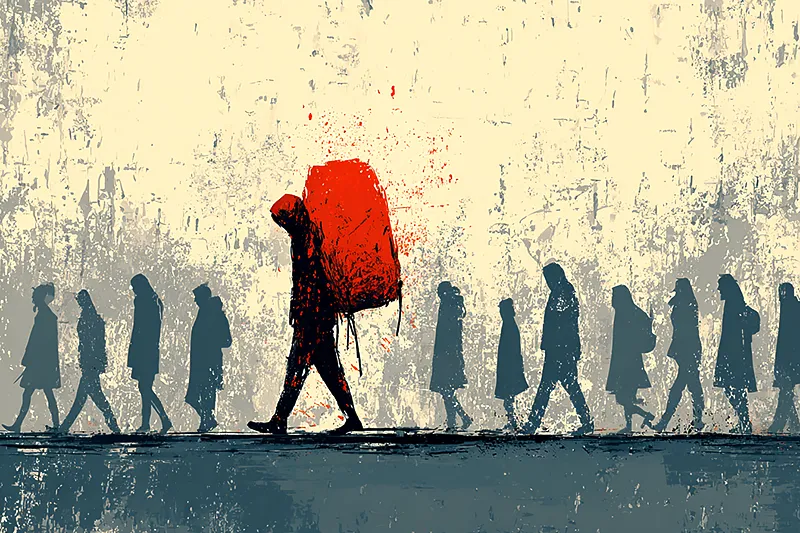The Weight We Carry: Understanding Gen Z’s Mental Health Crisis Through New Data
breathe in. breathe out. let’s sit with this together.
There’s this moment. You know the one. When you’re scrolling through your phone at 2:47am and suddenly realize that half your friend group is in therapy. When “mental health check” becomes as normal as asking about the weather. When emergency room visits for anxiety become… just another Tuesday.
We’ve been calling it a crisis for so long that the word has lost its sharp edges. But new data from PopHIVE’s emergency department surveillance just handed us a mirror, and friends… what we see there is both devastating and illuminating.
pause. breathe. let me paint you a picture with numbers that bleed.
When Anxiety Becomes an Emergency
Here’s the thing about emergency departments: they’re not where you go when you’re “a little stressed.” They’re where you land when your internal alarm system has been screaming so loud for so long that you can’t… you just can’t anymore.
And right now?
1 in every 40 Gen Z emergency room visits is for anxiety disorders.
Let that sink in like honey in hot tea. Not a therapist’s office. Not a school counselor. The emergency room.
- Ages 12-17: 2,300 anxiety-related visits per 100,000 total ER visits
- Ages 18-34: 2,863 per 100,000
the numbers climb as we get older, like we’re collecting anxiety the way other generations collected baseball cards
The Top 10 Shadows We’re Wrestling
PopHIVE’s data reads like a map of our collective pain, and honey, it’s time we name these shadows out loud:
1. Anxiety Disorders - the crown jewel of chaos
The absolute champion of what’s breaking us. Think of anxiety like a smoke detector that’s been rewired wrong - going off for burnt toast, for sunny days, for existing while young in 2025.
2. Suicide Attempts - the emergency that stops time
784 per 100,000 visits for teens. 263 for young adults. quiet for a moment Those numbers represent someone’s daughter. Someone’s best friend. Someone’s tomorrow that almost wasn’t.
3. Depression - the heavy gray blanket
When getting out of bed feels like climbing Everest in flip-flops.
4. Self-Harm - when pain needs a language
Sometimes the only way to make the inside hurt visible.
5. Substance Use - self-medication gone sideways
When coping mechanisms become their own problem.
6. ADHD/Attention Disorders - brains that won’t stay in their lane
The neurodivergent experience in a world built for neurotypical minds.
7. Eating Disorders - control when everything feels chaotic
When food becomes the battlefield for feelings that have nowhere else to go.
8. PTSD/Trauma - when the past won’t stay buried
Growing up with school shooter drills will do that to a generation.
9. Bipolar Disorder - emotional roller coasters without safety restraints
The highs that feel like flying and the lows that feel like drowning.
10. Psychotic Disorders - when reality becomes negotiable
The mind’s way of protecting itself when everything else fails.
The Perfect Storm We’re Swimming In
leans in closer, voice soft but urgent
Here’s what the data won’t tell you but we all know in our bones: we’re not broken. We’re responding exactly as we should to a world that’s… a lot.
We’re the generation that:
- Grew up with active shooter drills instead of fire drills
- Watched democracy get litigated on TikTok
- Inherited a planet on fire and a economy that gatekeeps basic survival behind unpaid internships
- Had our formative years interrupted by a global pandemic
- Live in a constant state of comparison thanks to social media algorithms designed to exploit our insecurities
of course our nervous systems are screaming.
What These Emergency Rooms Are Really Telling Us
Those anxiety visits? They’re not the problem - they’re the symptom. They’re the check engine light on our collective soul.
Every emergency room visit represents:
- Months of trying to “just push through”
- Systems that failed before the crisis hit
- A young person who ran out of other options
- A moment when surviving became more important than appearing “fine”
and maybe… maybe that’s actually progress?
The Quiet Revolution in Our Pain
Because here’s what gives me hope in all this darkness: we’re not suffering in silence anymore.
Previous generations carried their mental health struggles like state secrets. We? We’re showing up to emergency rooms. We’re demanding help. We’re saying “this isn’t sustainable” and “I matter enough to fight for my own healing.”
Every one of those ED visits is an act of revolution. A refusal to disappear quietly into despair.
we’re not just falling apart - we’re falling apart out loud, together
Where We Go From Here
This data isn’t an indictment. It’s an invitation.
An invitation to:
- Stop pathologizing normal responses to abnormal circumstances
- Build systems that catch people before they’re in crisis
- Recognize that mental health IS health
- Understand that healing happens in community, not isolation
soft but fierce
We deserve better than emergency rooms as our primary mental health intervention. We deserve prevention, not just crisis management. We deserve a world that sees our struggles not as personal failures but as signals that something fundamental needs to change.
In our next piece, we’ll explore how geography and identity shape this crisis in ways that will break your heart wide open - and maybe, just maybe, light a fire under you to help fix it.
**If you’re reading this and recognizing yourself in these numbers: You’re not alone. You’re not too much. You’re not broken. You’re just human, living in complicated times, and that’s okay.
Help is real. Healing is possible. Tomorrow can be different.**
Crisis resources: 988 (Suicide & Crisis Lifeline), Crisis Text Line (text HOME to 741741), or your local emergency room - because sometimes, asking for help is the brave thing.
This piece was created using data from PopHIVE’s CDC surveillance systems. Every number represents a real person, deserving of care, compassion, and hope.
 Not all weight is visible. Not all resilience is optional.
Not all weight is visible. Not all resilience is optional. 